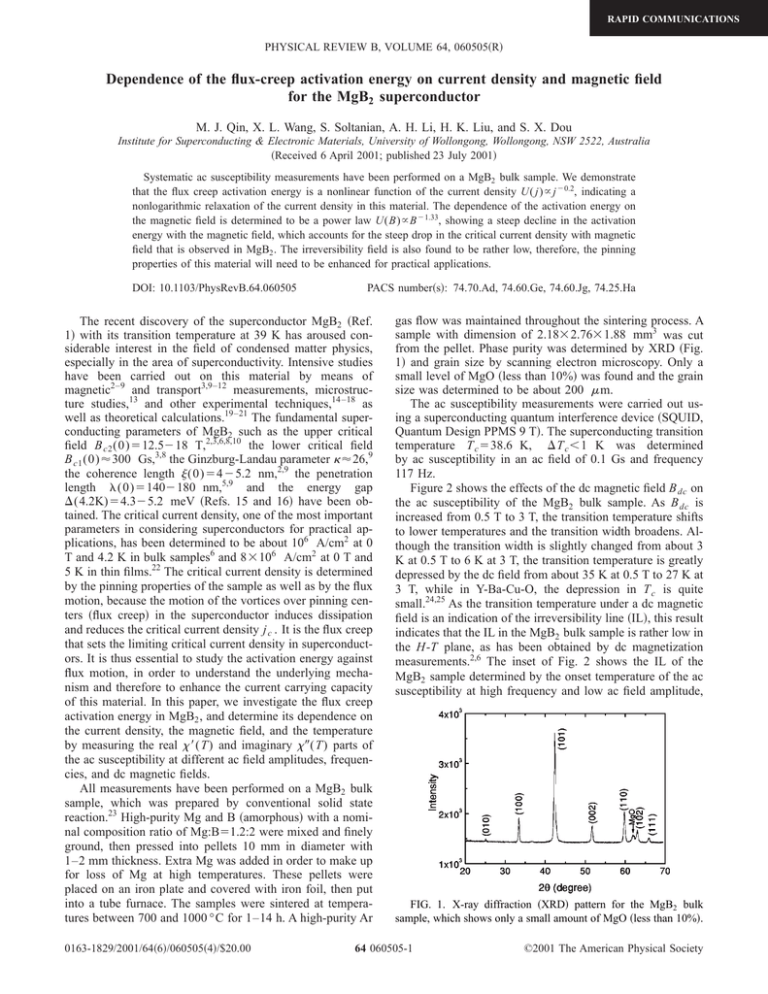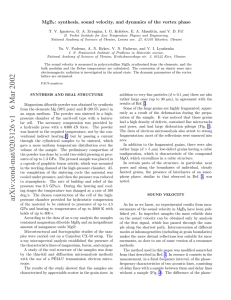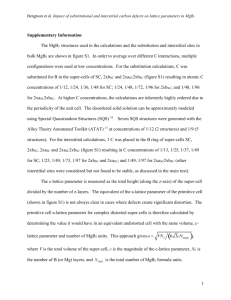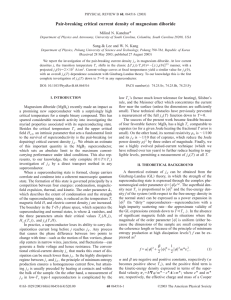Dependence of the flux-creep activation energy on current density and... for the MgB superconductor
advertisement

RAPID COMMUNICATIONS PHYSICAL REVIEW B, VOLUME 64, 060505共R兲 Dependence of the flux-creep activation energy on current density and magnetic field for the MgB2 superconductor M. J. Qin, X. L. Wang, S. Soltanian, A. H. Li, H. K. Liu, and S. X. Dou Institute for Superconducting & Electronic Materials, University of Wollongong, Wollongong, NSW 2522, Australia 共Received 6 April 2001; published 23 July 2001兲 Systematic ac susceptibility measurements have been performed on a MgB2 bulk sample. We demonstrate that the flux creep activation energy is a nonlinear function of the current density U( j)⬀ j ⫺0.2, indicating a nonlogarithmic relaxation of the current density in this material. The dependence of the activation energy on the magnetic field is determined to be a power law U(B)⬀B ⫺1.33, showing a steep decline in the activation energy with the magnetic field, which accounts for the steep drop in the critical current density with magnetic field that is observed in MgB2 . The irreversibility field is also found to be rather low, therefore, the pinning properties of this material will need to be enhanced for practical applications. DOI: 10.1103/PhysRevB.64.060505 PACS number共s兲: 74.70.Ad, 74.60.Ge, 74.60.Jg, 74.25.Ha The recent discovery of the superconductor MgB2 共Ref. 1兲 with its transition temperature at 39 K has aroused considerable interest in the field of condensed matter physics, especially in the area of superconductivity. Intensive studies have been carried out on this material by means of magnetic2–9 and transport3,9–12 measurements, microstructure studies,13 and other experimental techniques,14 –18 as well as theoretical calculations.19–21 The fundamental superconducting parameters of MgB2 such as the upper critical field B c2 (0)⫽12.5⫺18 T,2,3,6,8,10 the lower critical field B c1 (0)⬇300 Gs,3,8 the Ginzburg-Landau parameter ⬇26,9 the coherence length (0)⫽4⫺5.2 nm,2,9 the penetration length (0)⫽140⫺180 nm,5,9 and the energy gap ⌬(4.2K)⫽4.3⫺5.2 meV 共Refs. 15 and 16兲 have been obtained. The critical current density, one of the most important parameters in considering superconductors for practical applications, has been determined to be about 106 A/cm2 at 0 T and 4.2 K in bulk samples6 and 8⫻106 A/cm2 at 0 T and 5 K in thin films.22 The critical current density is determined by the pinning properties of the sample as well as by the flux motion, because the motion of the vortices over pinning centers 共flux creep兲 in the superconductor induces dissipation and reduces the critical current density j c . It is the flux creep that sets the limiting critical current density in superconductors. It is thus essential to study the activation energy against flux motion, in order to understand the underlying mechanism and therefore to enhance the current carrying capacity of this material. In this paper, we investigate the flux creep activation energy in MgB2 , and determine its dependence on the current density, the magnetic field, and the temperature by measuring the real ⬘ (T) and imaginary ⬙ (T) parts of the ac susceptibility at different ac field amplitudes, frequencies, and dc magnetic fields. All measurements have been performed on a MgB2 bulk sample, which was prepared by conventional solid state reaction.23 High-purity Mg and B 共amorphous兲 with a nominal composition ratio of Mg:B⫽1.2:2 were mixed and finely ground, then pressed into pellets 10 mm in diameter with 1–2 mm thickness. Extra Mg was added in order to make up for loss of Mg at high temperatures. These pellets were placed on an iron plate and covered with iron foil, then put into a tube furnace. The samples were sintered at temperatures between 700 and 1000 °C for 1–14 h. A high-purity Ar 0163-1829/2001/64共6兲/060505共4兲/$20.00 gas flow was maintained throughout the sintering process. A sample with dimension of 2.18⫻2.76⫻1.88 mm3 was cut from the pellet. Phase purity was determined by XRD 共Fig. 1兲 and grain size by scanning electron microscopy. Only a small level of MgO 共less than 10%兲 was found and the grain size was determined to be about 200 m. The ac susceptibility measurements were carried out using a superconducting quantum interference device 共SQUID, Quantum Design PPMS 9 T兲. The superconducting transition temperature T c ⫽38.6 K, ⌬T c ⬍1 K was determined by ac susceptibility in an ac field of 0.1 Gs and frequency 117 Hz. Figure 2 shows the effects of the dc magnetic field B dc on the ac susceptibility of the MgB2 bulk sample. As B dc is increased from 0.5 T to 3 T, the transition temperature shifts to lower temperatures and the transition width broadens. Although the transition width is slightly changed from about 3 K at 0.5 T to 6 K at 3 T, the transition temperature is greatly depressed by the dc field from about 35 K at 0.5 T to 27 K at 3 T, while in Y-Ba-Cu-O, the depression in T c is quite small.24,25 As the transition temperature under a dc magnetic field is an indication of the irreversibility line 共IL兲, this result indicates that the IL in the MgB2 bulk sample is rather low in the H-T plane, as has been obtained by dc magnetization measurements.2,6 The inset of Fig. 2 shows the IL of the MgB2 sample determined by the onset temperature of the ac susceptibility at high frequency and low ac field amplitude, FIG. 1. X-ray diffraction 共XRD兲 pattern for the MgB2 bulk sample, which shows only a small amount of MgO 共less than 10%兲. 64 060505-1 ©2001 The American Physical Society RAPID COMMUNICATIONS QIN, WANG, SOLTANIAN, LI, LIU, AND DOU PHYSICAL REVIEW B 64 060505共R兲 FIG. 2. ⬘ (T) and ⬙ (T) curves of the MgB2 bulk sample at B ac ⫽1 Gs, f ⫽1117 Hz, and B dc ⫽0.5, 1, 2, 3 T. Inset shows the irreversibility line 共solid line is just a guide to the eye兲. FIG. 4. ⬘ (T) and ⬙ (T) curves of the MgB2 bulk sample at B dc ⫽0.5 T, B ac ⫽2 Gs, and f ⫽17, 51, 117, 351, 1117, 3331, 9999 Hz 共from left to right兲. which is higher than the ILs by dc measurements.2,6 The reason is that the IL determined by ac measurement is frequency and ac field amplitude dependent and therefore is not reliable, as has been discussed in detail by Deak et al.,26 it is only a rough estimation. Shown in Fig. 3 are typical ⬘ (T) and ⬙ (T) curves for the MgB2 bulk sample at B dc ⫽1 T, f ⫽1117 Hz and different ac field amplitudes B ac indicated. As B ac is increased, the transition shifts to lower temperatures with increased width. In Fig. 4, we show the effects of the frequency on the ac susceptibility of this MgB2 bulk sample. Contrary to the effects of B ac and B dc , as f is increased, the transition shifts to higher temperatures and the transition width broadens. All the characteristics shown in Figs. 2– 4 for the MgB2 bulk sample are similar to what have been observed in hightemperature superconductors24,25 and predicted from theoretical calculations.27 This is understandable, because ac susceptibility at different dc magnetic fields, ac field amplitudes, and frequencies reflects a common phenomenon, i.e., flux dynamics in type-II superconductors. A measurement of the superconducting transition by means of the ac susceptibility ⫽ ⬘ ⫹i ⬙ typically shows, just below the critical temperature T c , a sharp decrease in the real part of the susceptibility ⬘ , a consequence of diamagnetic shielding, and a peak in the imaginary part of the susceptibility ⬙ , representing losses. The peak in ⬙ will occur when the flux front reaches the center of the sample. It follows that the position of the peak in ⬙ will also strongly depend on temperature, dc field, ac field amplitude, and frequency. The criterion for the peak in ⬙ is28 U 共 T p ,B dc , j 兲 ⫽U 共 T p 兲 U 共 B dc 兲 U 共 j 兲 ⫽k BT p ln 2 where the time scale t 0 ⫽4 0 H ac / 0 j 2 ( ),28 0 is the prefactor in the Arrhenius law ⫽ 0 exp关⫺U(j)/kBT 兴 , T p is the peak temperature in the ⬙ (T) curve, and k B the Boltzmann constant. It has been shown27 by numerical calculation that during the penetration by the ac magnetic-field into a superconductor, the magnetic-field profile can be regarded as a straight line, so at the peak temperature the current density can be approximated as H ac , 共2兲 j⫽ d where d is the sample size. A plot of ⫺ln f peak versus U(T p )/k BT p should thus be a straight line with the slope of U( j,B dc ), U共 T 兲 U 共 j,B dc 兲 ⫽⫺ln共 f 兲 ⫺ln共 t 0 兲 . k BT 共3兲 By varying the ac amplitude and then using Eq. 共2兲 to determine the current density, one can then reconstruct the current density dependence of the activation energy U( j). Using the ac method the usual difficulty in conventional relaxation measurements of having only a very limited time window (1⬃104 s) can be overcome by extending the latter to smaller values of 10⫺5 ⬃10⫺3 s ( f ⫽100 kHz– 1 kHz).24,25 In order to account for the explicit temperature dependence of the activation energy, we choose a form of the temperature scaling function U 共 T 兲 ⫽ 关 1⫺ 共 T/T x 兲 2 兴 2 , FIG. 3. ⬘ (T) and ⬙ (T) curves of the MgB2 bulk sample at B dc ⫽1 T, f ⫽1117 Hz, and B ac ⫽0.1, 0.5, 1, 2, 5, 10, 15 Gs 共from right to left兲. 1 , 共1兲 f peakt 0 共4兲 where T x ⫽36.3,34.3,31.5,29.1 K for B dc ⫽0.5,1,2,3 T, respectively, is a characteristic temperature, which is taken from the IL. U(T) changes slightly with temperature for T ⰆT x and drops rapidly as T approaches T x . A detailed discussion on choosing the function U(T) has been given by McHenry et al.29 060505-2 RAPID COMMUNICATIONS DEPENDENCE OF THE FLUX-CREEP ACTIVATION . . . PHYSICAL REVIEW B 64 060505共R兲 FIG. 5. ⫺ln f peak versus U(T p )/k BT p of the MgB2 sample at various current densities indicated by different symbols. Solid lines are linear fits calculated from Eq. 共3兲. FIG. 7. Activation energy U(B)⬀U( j,B dc )⫻ j 0.21 as a function of the magnetic field for the MgB2 bulk sample at various current densities. The solid line is the fitting curve U(B)⬀B ⫺1.33. Figure 5 shows ⫺ln f peak versus U(T p )/k BT p curves at B dc ⫽0.5 T and various current densities. The experimental data can be fitted very well by straight lines 关Eq. 共3兲兴, solid lines in Fig. 5兲. We can then derive the activation energy U( j,B dc ⫽0.5 T) from the slopes of the straight lines. U( j,B dc ) at other dc magnetic fields have also been derived, and the results are summarized in Fig. 6, where the activation energy U( j)⬀U( j,B dc )⫻B 1.3 is plotted as a function of the current density for the MgB2 bulk sample at various dc magnetic fields. As can be seen from Fig. 6, we have obtained a universal curve U( j) by scaling the data by B 1.3. The slight scattering at low current density may result from the field-dependent critical current density j c (B). Note that B ac has been changed to j by using Eq. 共2兲, where d is the sample size rather than the grain size, because it has been reported2 that current flow in MgB2 is strongly linked. The current density j obtained here is also very close to what has been derived using magnetization measurements.23 From the best fit of the data in Fig. 6, we derived the current-density-dependent activation energy U( j)⬀ j ⫺0.2, which is highly nonlinear. This result suggests that the I-V curve of MgB2 should also be highly nonlinear, because using the Arrhenius rate equation, we have E⫽B v 0 ⫽B v 0 exp关 ⫺U( j)/k BT 兴 ⬀exp(⫺ j ⫺ ). Nonlinear I-V characteristics have been experimentally observed in MgB2 .12 On the other hand, the relaxation of the current density or the magnetization can be derived from Eq. 共1兲 as j(t) ⬀ 关 ln(t/t 0 ) 兴 ⫺1/ , which is also a nonlinear function of ln(t/t 0 ). This nonlogarithmic relaxation can be detected by means of dc magnetization relaxation measurements, which will be discussed in one of our forthcoming works. As can be seen from Eq. 共3兲, with the current density j fixed, we can also derive the activation energy as a function of the dc magnetic field U(B). The results are summarized in Fig. 7, where the activation energy U(B)⬀U( j,B dc )⫻ j 0.21 is plotted as a function of the magnetic field for the MgB2 bulk sample at various current densities. As can be seen from Fig. 7, we have also obtained a universal curve by scaling the data by j 0.21. This current density dependence is consistent with the one derived in Fig. 6. As the scaling factor B 0 关see Eq. 共5兲 below兴 for B is current density independent, we can see that the scaling of U(B) is much better than that of U( j) shown in Fig. 6. The solid line in Fig. 7 is a fit to the power law U(B)⬀B ⫺1.33. The obtained U(B) is also consistent with the one derived from scaling in Fig. 6. The selfconsistent scalings of U( j,B) shown in Fig. 6 and Fig. 7 suggest that the separation of the activation energy U( j,B,T) to U( j)U(T)U(B) in Eq. 共1兲 is quite reasonable. The final expression for the temperature-, field-, and current-densitydependent activation energy is given by 冋 冉 冊册冉 冊 冉 冊 U 共 T,B, j 兲 ⫽U 0 1⫺ FIG. 6. Activation energy U( j)⬀U( j,B dc )⫻B 1.3 as a function of the current density for the MgB2 bulk sample at various dc magnetic fields. The solid line is the fitting curve U( j)⬀ j ⫺0.2. T Tx 2 2 B B0 ⫺n j0 j 共5兲 where U 0 , B 0 , and j 0 are scaling values, and the exponents n and are determined to be 1.33 and 0.2, respectively. As for the magnetic-field dependence of the activation energy, a B ⫺1 dependence has been previously derived using the Anderson-Kim model of the activation energy combined with the Ginzburg-Landau expressions for the coherence length, thermodynamic critical field and depairing critical current density, etc.30,31 Such a B ⫺1 dependence has been observed in a La1.86Sr0.14CuO4 single crystal with weak pinning centers by McHenry et al.29 In addition, for YBa2 Cu3 Ox samples with strong pinning centers, such as twin planes, stacking faults or Y2 BaCuO5 inclusions, a U(B)⬃B ⫺0.5 has been derived by both ac susceptibility25 and dc magnetization measurements.32,33 060505-3 RAPID COMMUNICATIONS QIN, WANG, SOLTANIAN, LI, LIU, AND DOU PHYSICAL REVIEW B 64 060505共R兲 For the superconductor MgB2 on the other hand, we find a U(B)⬃B ⫺1.33 dependence, showing that the activation energy decreases even faster with increasing magnetic field, compared to a weakly pinned high-temperature superconducting La1.86Sr0.14CuO4 single crystal. The weakening of the activation energy with increasing magnetic field may be the reason why the critical current density drops steeply as the magnetic field increases, as has been observed by dc magnetization measurements.2– 6,9 Taking into account the relatively low irreversibility line 共Fig. 2兲 and the weakening of the activation energy with increasing magnetic field, the pinning properties of MgB2 need to be enhanced for practical applications. 1 J. Nagamatsu, N. Nakagawa, T. Maranaka, Y. Zenitani, and J. Akimitsu, Nature 共London兲 410, 63 共2001兲. 2 D. C. Larbalestier, M. O. Rikel, L. D. Cooley, A. A. Polyanskii, J. Y. Jiang, S. Patnaik, X. Y. Cai, D. M. Feldmann, A. Gurevich, A. A. Squitieri, M. T. Naus, C. B. Eom, E. E. Hellstrom, R. J. Cava, K. A. Regan, N. Rogado, M. A. Hayward, T. He, J. S. Slusky, P. Khalifah, K. Inumaru, and M. Haas, Nature 共London兲 410, 186 共2001兲. 3 Y. Takano, H. Takeya, H. Fujii, H. Kumakura, T. Hatano, K. Togano, H. Kito, and H. Ihara, cond-mat/0102167 共unpublished兲. 4 Y. Bugoslavsky, G. K. Perkins, X. Qi, L. F. Cohen, and A. D. Caplin, cond-mat/0102353 共unpublished兲. 5 X. H. Chen, Y. Y. Xue, R. L. Meng, and C. W. Chu, cond-mat/0103029 共unpublished兲. 6 H. H. Wen, S. L. Li, Z. W. Zhao, Y. M. Ni, Z. A. Ren, G. C. Che, and Z. X. Zhao, cond-mat/0103521 共unpublished兲. 7 O. F. de Lima, R. A. Ribeiro, M. A. Avila, C. A. Cardoso, and A. A. Coelho, Phys. Rev. Lett. 86, 5974 共2001兲. 8 Amish G. Joshi, C. G. S. Pillai, P. Raj, and S. K. Malik, cond-mat/0103302 共unpublished兲. 9 D. K. Finnemore, J. E. Ostenson, S. L. Bud’ko, G. Lapertot, and P. C. Canfield, Phys. Rev. Lett. 86, 2420 共2001兲. 10 S. L. Bud’ko, C. Petrovic, G. Lapertot, C. E. Cunningham, P. C. Canfield, M. H. Jung, and A. H. Lacerda, Phys. Rev. B 63, 220505 共2001兲. 11 W. N. Kang, Kijoon H. P. Kim, Hyeong-Jin Kim, Eun-Mi Choi, Min-Seok Park, Mun-Seog Kim, Zhonglian Du, Chang Uk Jung, Kyung Hee Kim, Sung-Ik Lee, and Mi-Ock Mun, cond-mat/0103161 共unpublished兲. 12 Kijoon H. P. Kim, W. N. Kang, Mun-Seog Kim, C. U. Jung, Hyeong-Jin Kim, Eun-Mi Choi, Min-Seok Park, and Sung-Ik Lee, cond-mat/0103176 共unpublished兲. 13 Gun Yong Sung, Sang Hyeob Kim, JunHo Kim, Dong Chul Yoo, Ju Wook Lee, Jeong Yong Lee, C. U. Jung, Min-Seok Park, W. N. Kang, Du Zhonglian, and Sung-Ik Lee, cond-mat/0102498 共unpublished兲. 14 W. N. Kang, C. U. Jung, Kijoon H. P. Kim, Min-Seok Park, S. Y. Lee, Hyeong-Jin Kim, Eun-Mi Choi, Kyung Hee Kim, MunSeog Kim, and Sung-Ik Lee, cond-mat/0102313 共unpublished兲. In summary, we have performed systematically ac susceptibility measurements on a MgB2 bulk sample. The magnetic-field- and current-density-dependent flux creep activation energy has been determined to be U( j,B) ⬀ j ⫺0.2B ⫺1.33. Compared to high-temperature superconductors U(B)⬃B ⫺1 for a weakly pinned La1.86Sr0.14CuO4 single crystal and U(B)⬃B ⫺0.5 for strongly pinned YBa2 Cu3 Ox , the steeply declining dependence U(B)⬃B ⫺1.33 results in a steep drop in j c with magnetic field and suggests that pinning in MgB2 is quite weak, as can also be seen from the low irreversibility field. The authors would like to thank the Australian Research Council for financial support. 15 G. Karapetrov, M. Iavarone, W. K. Kwoa, G. W. Crabtree, and D. G. Hinks, cond-mat/0102312 共unpublished兲. 16 Herbert Schmidt, J. F. Zasadzinski, K. E. Gray, and D. G. Hinks, Phys. Rev. B 63, 220504 共2000兲. 17 T. Takahashi, T. Sato, S. Souma, T. Muranaka, and J. Akimitsu, Phys. Rev. Lett. 86, 4915 共2001兲. 18 J. D. Jorgensen, D. G. Hinks, and S. Short, Phys. Rev. B 63, 224522 共2001兲. 19 N. I. Medvedeva, A. L. Ivanovskii, J. E. Medvedeva, and A. J. Freeman, Phys. Rev. B 63, 020502 共2001兲. 20 K. Voelker, V. I. Anisimov, and T. M. Rice, cond-mat/0103082 共unpublished兲. 21 S. V. Shulga, S. L. Drechsler, H. Eschrig, H. Rosner, and W. Pickett, cond-mat/0103154 共unpublished兲. 22 W. N. Kang, Hyeong-Jin Kim, Eun-Mi Choi, C. U. Jung, and Sung-Ik Lee, cond-mat/0103179 共unpublished兲. 23 S. X. Dou, X. L. Wang, J. Horvat, D. Milliken, E. W. Collings, and M. D. Sumption, cond-mat/0102320 共unpublished兲. 24 S. Y. Ding, G. Q. Wang, X. X. Yao, H. T. Peng, Q. Y. Peng, and S. H. Zhou, Phys. Rev. B 51, 9107 共1995兲. 25 M. J. Qin, S. Y. Ding, C. Ren, X. X. Yao, Y. X. Fu, C. B. Cai, T. S. Shi, and G. Y. Wang, Physica C 262, 127 共1996兲. 26 J. Deak, M. McElfresh, J. R. Clem, Z. D. Hao, M. Konczykowski, R. Muenchausen, S. Foltyn, and R. Dye, Phys. Rev. B 49, 6270 共1994兲. 27 M. J. Qin and X. X. Yao, Phys. Rev. B 54, 7536 共1996兲; Physica C 272, 142 共1996兲; 282-287, 2229 共1997兲. 28 G. Blatter, M. V. Feigel’man, V. B. Geshkenbein, A. I. Larkin, and V. M. Vinokur, Rev. Mod. Phys. 66, 1125 共1994兲. 29 M. E. McHenry, S. Simizu, H. Lessure, M. P. Maley, J. Y. Coulter, I. Tanaka, and H. Kojima, Phys. Rev. B 44, 7614 共1991兲. 30 Y. Yeshurun and A. P. Malozemoff, Phys. Rev. Lett. 60, 2202 共1988兲. 31 M. Tinkham, Phys. Rev. Lett. 61, 1658 共1988兲. 32 P. J. Kung, M. P. Maley, M. E. McHenry, J. O. Willis, J. Y. Coulter, M. Murakami, and S. Tanaka, Phys. Rev. B 46, 6427 共1992兲. 33 P. J. Kung, M. P. Maley, M. E. McHenry, J. O. Willis, M. Murakami, and S. Tanaka, Phys. Rev. B 48, 13 922 共1993兲. 060505-4




